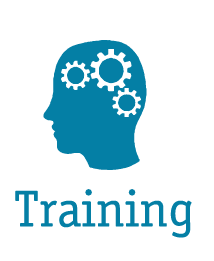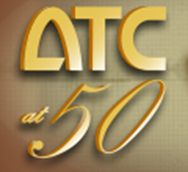| ATC Project No. | Project Title | Funding Agency | ||
| ATC-15-13 |
14th U.S.-Japan Workshop on the Improvement of Structural Design and Construction Practices |
Applied Technology Council (ATC) |  |
|
| ATC-15-14 |
15th U.S.-Japan Workshop on the Improvement of Structural Engineering and Resiliency |
Applied Technology Council (ATC) |  |
|
| ATC-15-15 | 16th U.S.-Japan-New Zealand Workshop on the Improvement of Structural Engineering and Resiliency | Applied Technology Council (ATC) |  |
|
| ATC-15-16 | 17th U.S.-Japan-New Zealand Workshop on the Improvement of Structural Engineering and Resiliency | Applied Technology Council, Japan Structural Consultants Association, New Zealand Centre of Research Excellence (QuakeCoRE), and New Zealand Society for Earthquake Engineering |  |
|
| ATC-15-17 | 18th U.S.-Japan-New Zealand Workshop on the Improvement of Structural Engineering and Resiliency |
Applied Technology Council |
 |
|
| ATC-20 |
Procedures for Postearthquake Safety Evaluation of Buildings |
Applied Technology Council (ATC) |  |
|
| ATC-20-1 Bhutan |
Development of Field Manual: Postearthquake Safety Evaluation of Buildings, Bhutan Edition | World Bank’s Global Facility for Disaster Reduction and Recovery (GFDRR) | ||
| ATC-45 |
Field Manual: Safety Evaluation of Buildings After Wind Storms and Floods |
Applied Technology Council (ATC) |  |
|
| ATC-52-2 (CAPSS) |
San Francisco Department of Building Inspection |  |
||
| ATC-58 Series | Development of Next Generation Performance-Based Seismic Design Procedures for New and Existing Buildings | Federal Emergency Management Agency | 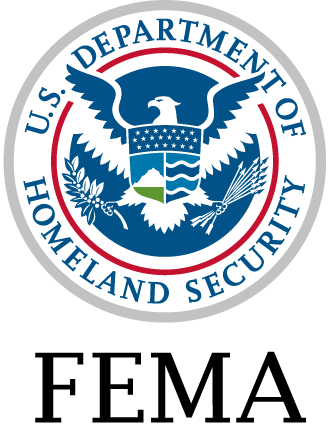 |
|
| ATC-60 | Structural Engineers Association of Washington | 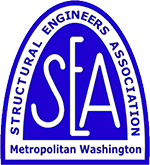 |
||
| ATC-63-1 | Federal Emergency Management Agency |  |
||
| ATC-64 | Federal Emergency Management Agency |  |
||
| ATC-66 Series | NETAP (National Earthquake Technical Assistance Program) Training | Federal Emergency Management Agency |  |
|
| ATC-67-4 | Federal Emergency Management Agency |  |
||
| ATC-69 Series |
Development of FEMA E-74, Reducing the Risks of Nonstructural Earthquake Damage - A Practical Guide |
Federal Emergency Management Agency |  |
|
| ATC-71 |
Update Seismic Rehabilitation Guidance Program Definition and Guidance Development |
Federal Emergency Management Agency |  |
|
| ATC-71-1 | Federal Emergency Management Agency |  |
||
| ATC-71-2 |
Planning and Conduct of an Earthquake Building Performance Rating System Workshop |
Federal Emergency Management Agency |  |
|
| ATC-75 |
Development of Industry Foundation Classes (IFCs) for Structural components |
Charles Pankow Foundation | ||
| ATC-76-1 | Quantification of Building System Performance and Response Parameters. This task has been completed and produced the NIST GCR 10-917-8 report, Evaluation of the FEMA P-695 Methodology for Quantification of Building Seismic Performance Factors. | National Institute of Standards and Technology | ||
| ATC-76-5 | Integration of Collapse Risk Mitigation Standards and Guidelines for Older Reinforced Concrete Buildings into National Standards - Phase I. This task has been completed and produced the NIST GCR 10-917-7 report, Program Plan for the Development of Collapse Assessment and Mitigation Strategies for Existing Reinforced Concrete Buildings. | National Institute of Standards and Technology | ||
| ATC-76-6 | Improved Nonlinear Static Seismic Analysis Procedures - Multiple-Degree-of-Freedom Modeling. This task has been completed and produced the NIST GCR reports, 10-917-9, Applicability of Nonlinear Multiple-Degree-of-Freedom Modeling for Design, and Supporting Documentation. | National Institute of Standards and Technology | ||
| ATC-78 Series | Identification and Mitigation of Nonductile Concrete Buildings | Federal Emergency Management Agency |  |
|
| ATC-79/79-1 | Federal Emergency Management Agency |  |
||
| ATC-81 | ACI Foundation | |||
| ATC-86 | Federal Emergency Management Agency |  |
||
| ATC-99 |
Methodology to Assess and Verify the Seismic Capacity of Low-Rise Buildings |
Federal Emergency Management Agency |  |
|
| ATC-99-1 |
Methodology to Assess and Verify the Seismic Capacity of Low-Rise Buildings |
Federal Emergency Management Agency |  |
|
| ATC-102 | Development of an Earthquake-Resilient Lifelines: NEHRP Research and Implementation Roadmap | National Institute of Standards and Technology | ||
| ATC-103 | Development of Technical Brief on Structural Design Issues – Seismic Design of Steel Special Concentrically Braced Frame Systems. This task has been completed and produced the NIST GCR 13-917-24 report, Technical Brief No. 8, Seismic Design of Steel Special Concentrically Braced Frame Systems: A Guide for Practicing Engineers. | National Institute of Standards and Technology | ||
| ATC-106-1 | Seismic Behavior and Design of Deep, Slender Wide-Flange Structural Steel Beam-Column Members: Phase 2 Experimental Evaluation | National Institute of Standards and Technology | ||
| ATC-109 | Building Safety Evaluation after the February 22, 2011 Christchurch, New Zealand Earthquake: Observations by the ATC Reconnaissance Team | Applied Technology Council (ATC) and ATC Endowment Fund |
 |
|
| ATC-110 (CEA 5/CEA 6) |
Delivery of FEMA P-50/P-50-1 Training for the California Earthquake Authority | California Earthquake Authority | ||
| ATC-111 | Development of Technical Brief on Structural Design Issues – Special Reinforced Masonry Shear Walls. This task has been completed and produced the NIST GCR 14-917-31 report, Technical Brief No. 9, Seismic Design of Special Reinforced Masonry Shear Walls: A Guide for Practicing Engineers | National Institute of Standards and Technology | ||
| ATC-112 | Development of Technical Brief on Structural Design Issues – Wood Light-Frame Structural Diaphragm Systems. This task has been completed and produced the NIST GCR 14-917-32 report, Technical Brief No. 10, Seismic Design of Wood Light-Frame Structural Diaphragm Systems: A Guide for Practicing Engineers | National Institute of Standards and Technology | ||
| ATC-114 | Development of Accurate Models and Efficient Simulation Capabilities for Collapse Analysis to Support Implementation of Performance Based Seismic Engineering. This task has been completed and produced four reports: NIST GCR 17-917-45, NIST GCR 17-917-46v1, NIST GCR 17-917-46v2, and NIST GCR 17-917-46v3 | National Institute of Standards and Technology | ||
| ATC-115 | Development of a Roadmap for the use of high-strength reinforcement in reinforced concrete design. This task has been completed and produced the ATC-115 report, Roadmap for the Use of High-Strength Reinforcement in Reinforced Concrete Design. | Charles Pankow Foundation | ||
| ATC-116 Series | Solutions to the Issues of Short-Period Building Seismic Performance | Federal Emergency Management Agency |  |
|
| ATC-118 | Development of a Emergency Power for Critical Facilities Guidance Publication. This task has been completed and produced the FEMA P-1019 report, Emergency Power for Critical Facilities: A Best Practices Approach to Improving Reliability. | Federal Emergency Management Agency |  |
|
| ATC-119 Series | Seismic Safety and Engineering Consulting Services for the Earthquake Safety Implementation Program (ESIP) | City and County of San Francisco | ||
| ATC-120 Series | Seismic Analysis and Design of Nonstructural Components and Systems | National Institute of Standards and Technology | ||
| ATC-121 | Development of Technical Brief on Structural Design Issues – Steel Buckling-Restrained Braced Frames. This task has been completed and produced the NIST GCR 15-917-34 report, Technical Brief No. 11, Structural Design Issues: Seismic Design of Steel Buckling-Restrained Braced Frames, A Guide for Practicing Engineers | National Institute of Standards and Technology | ||
| ATC-122 Series | Reducing the Risk to our Schools from Natural Hazards and Improving the Safety of Our Children. This task has been completed and produced the report, FEMA P-1000, Safer, Stronger, Smarter: A Guide to Improving School Natural Hazard Safety | Federal Emergency Management Agency |  |
|
| ATC-123 Series | Improving Seismic Design of New Buildings | Federal Emergency Management Agency |  |
|
| ATC-124 Series | Update of Seismic Retrofitting Guidance | Federal Emergency Management Agency |  |
|
| ATC-125 | Recovery Advisories for the South Napa Earthquake | Federal Emergency Management Agency |  |
|
| ATC-126 | ATC Project, Community Resilience of Lifeline Systems, produced the NIST CGR 16-917-39 report, Critical Assessment of Lifeline System Performance: Understanding Societal Needs in Disaster Recovery | National Institute of Standards and Technology | ||
| ATC-127 | User-Needs Workshop for the National Seismic Hazard Mapping Project | U.S. Geological Survey | ||
| ATC-128 | Proceedings of Forum on Performance-Based Structural-Fire Engineering: Examples of Current Practice and Discussion on Future Directions | Applied Technology Council (ATC) and ATC Endowment Fund |
 |
|
| ATC-129 | Development of Updated Standards of Seismic Safety for Existing Federally Owned and Leased Buildings | National Institute of Standards and Technology | ||
| ATC-130 | Updates of NEHRP Seismic Design Technical Briefs 1-3 | National Institute of Standards and Technology | ||
| ATC-131 | Development of Technical Brief on Structural Design Issues: Seismic Design of Cold-Formed Steel Lateral Load Resisting Systems | National Institute of Standards and Technology | ||
| ATC-132 | Practical Guidelines and Training for Ensuring Seismic Safety of Schools in the Republic of Armenia (Report available in English and Armenian) | World Bank, Global Program for Safer Schools | ||
| ATC-133 | Development of Technical Brief on Structural Design Issues: Seismic Design of Precast Concrete Diaphragms produced the NIST GCR 17-917-47 report, NEHRP Seismic Design Technical Brief No. 13, Seismic Design of Precast Concrete Diaphragms, A Guide for Practicing Engineers | National Institute of Standards and Technology | ||
| ATC-135 | Improving the Alternate Rigid-Wall Flexible-Diaphragm Building Design Procedure | Federal Emergency Management Agency |  |
|
| ATC-137 | Technical Assistance, Training and Product Development | Federal Emergency Management Agency |  |
|
| ATC-137-2 | Summit on Unreinforced Masonry Buildings in Utah | Federal Emergency Management Agency |  |
|
| ATC-139 | Investigation of Project 17 Duration Effects | ATC Endowment Fund |  |
|
| ATC-141 | Reconnaissance Following the September 19, 2017 Puebla Earthquake in Mexico City | ATC Endowment Fund |  |
|
| ATC-142 | Seismic Performance-Based Assessment of School Infrastructure in the Kyrgyz Republic | World Bank | ||
| ATC-143 | Update of General Guidelines for the Assessment and Repair of Earthquake Damage in Residential Woodframe Buildings and Development of Additional Engineering Guidelines | California Earthquake Authority | ||
| ATC-144 | Soil Structure Interaction Design Guide | Federal Emergency Management Agency |  |
|
| ATC-145 Series | Guide for Repair of Earthquake Damaged Buildings to Achieve Future Resilience | Federal Emergency Management Agency |  |
|
| ATC-146 | Steel Buildings in the Central and Eastern United States Designed for Controlling Wind Loads to Evaluate their Seismic Performance | National Institute of Standards and Technology | ||
| ATC-147 | Computational Models for Large Outdoor Fires Roadmap Workshop | National Institute of Standards and Technology | ||
| ATC-148 | Building Technical Capacity in Central Asia to Design Risk-Informed Public Infrastructure Investments at Scale | World Bank | ||
| ATC-164 | Workshop on Structural Design for Coastal Flood Resilience |
National Science Foundation |
  |
|
| Websites for Geographic Based Design Load Parameters |
Websites for Geographic Based Design Load Parameters: Ground Snow Loads and Windspeed. | Applied Technology Council (ATC) and ATC Endowment Fund |
 |
|
ATC-127 PROJECT
ATC/USGS Seismic Hazard User-Needs Workshop
On September 21-22, 2015, in Menlo Park, California, the Applied Technology Council (ATC) and U.S. Geological Survey (USGS) convened the ATC/USGS Seismic Hazard User-Needs Workshop. Like the ATC-35/USGS National Earthquake Ground Motion Mapping Workshops, which were held in 1995, 2001, and 2006, this User-Needs Workshop provided an opportunity for individuals and groups that use the National Seismic Hazard Maps to provide feedback on existing and planned hazard information and products from the USGS National Seismic Hazard Mapping Project.
Agenda. The Workshop Agenda is available here.
Presentations.
-
Day 1: Welcome and Introductory Remarks
Anna H. Olsen, Applied Technology Council
-
Session 1: Seismic Hazard Products and Their Intended Users
Moderator: Nicolas Luco, U.S. Geological Survey
Uses (or Types of Users & Products) of the USGS National Seismic Hazard Model (NSHM)
Nicolas Luco, U.S. Geological Survey
The 2014 National Seismic Hazard Maps: 67 Years in the Making
Mark D. Petersen, U.S. Geological Survey
Products and Tools from the National Seismic Hazard Model (NSHM)
Peter M. Powers, U.S. Geological Survey
-
Session 2: Use of Seismic Hazard at Individual Sites
Moderator: C.B. Crouse, AECOMUse of USGS Seismic Hazard Tools at Individual Sites—New Building Design Perspective
John D. Hooper, Magnusson Klemencic AssociatesUtilization of Seismic Hazard Information from USGS National Seismic Hazard Mapping Project by DSA*
Ronald W. LaPlante, California Division of the State ArchitectUsing ASCE 7-10 Performance Targets to Manage Seismic Risk in the Legal Arena*
Mark N. White, Law Offices of Mark N. WhiteQuakeUpLA: Creating an Interactive Seismic and Building Response Map Tool*
Brittany Moffett and Anders Carlson, University of Southern CaliforniaNeeds/Issues for Site-Specific Geotechnical Applications of the NSHMP Maps and Tools
John A. Egan, SAGE EngineersThe Travails of the Average Geotechnical Engineer Using the National Seismic Hazard Maps
Marshall Lew, AMEC Foster WheelerUse of NSHMP Products for Site-Specific Hazard Analyses for Critical Structures
Norman Abrahamson, Pacific Gas & Electric Company, San Francisco, CaliforniaUse of USGS National Seismic Hazard Mapping Program Products in USACE Dam and Levee Safety Programs and USACE Civil Works Projects
Keith Kelson, U.S. Army Corps of Engineers, Sacramento, CaliforniaSeismic Hazard for Commercial Nuclear Power Plants – Current Practice and Its Relationship to the NSHMP
Robert Youngs, AMEC Foster Wheeler, Oakland, California
-
Day 2: Welcome and Introductory Remarks
Anna H. Olsen, Applied Technology Council
-
Session 3: Use of Seismic Hazard at Distributed Sites
Moderator: Chris D. Poland, Consulting Engineer
Caltrans Reliance on USGS National Seismic Hazard Mapping Program
Tom Shantz, California Department of TransportationUse of Seismic Hazard Information in Water and Wastewater System Analysis
Don Ballantyne, Ballantyne ConsultingSeismic Hazard Analysis along the State Water Project California Department of Water Resources
Don F. Hoirup, Jr., California Department of Water ResourcesPacific Gas and Electric - Gas and Electric Systems
Kent S. Ferre, Pacific Gas & Electric CompanyCalifornia High-Speed Rail Authority: A Transformative Investment in California’s Future
Kevin Thompson and Kenneth W. Campbell, California High Speed Rail Authority
-
Session 4: Additional Uses of Seismic Hazard Information
Moderator: Janiele Maffei, California Earthquake Authority
The Science of Catastrophe Modeling: A Journey from Hazard to Risk
Maiclaire Bolton, CoreLogicUSGS and AIR Worldwide: Leveraging Seismic Hazard as an Ingredient in Risk Modeling
C. Marc Ramirez, AIR WorldwideUse of USGS National Seismic Hazard Model (NSHM) in Catastrophe Modeling: RMS Perspective
Nilesh Shome, RMSApplying Seismic Hazard Information in Local and Regional Urban Planning
Laurie A. Johnson, Laurie Johnson Consulting | ResearchThe USGS National Seismic Hazard Mapping Project: Issues and Improvements*
Zhenming Wang, Kentucky Geological SurveyCalifornia Geological Survey Project Review*
Jennifer Thornburg, California Geological SurveyCGS Utilization of USGS Seismic Hazard Information*
Rui Chen, California Geological Survey* Informal talk
Workshop Program. The ATC/USGS Seismic Hazard User-Needs Workshop was organized to (1) elicit feedback from users of seismic hazard information and products, (2) provide a forum for the wider earthquake engineering community to discuss the transfer of seismic hazard results into engineering practice, seismic risk analysis, and public policy, and (3) make practical recommendations to the USGS National Seismic Hazard Mapping Project.
The User-Needs Workshop included presentations from invited speakers and workshop attendees:
▪ Representatives of the National Seismic Hazard Mapping Project described the changes in the 2014 update of the National Seismic Hazard Maps, including changes to the hazard model input, the calculation of hazard, and the resulting differences in hazard values. The representatives also provided an overview of seismic hazard information and products currently available at the Project website.
▪ Representatives of user groups described how they use hazard information from the National Seismic Hazard Mapping Project. Users also provided feedback on the hazard products that they currently use and ideas about development of additional products or the consolidation of existing products.
Location. William Rambo Auditorium, U.S. Geological Survey, 345 Middlefield Road, Menlo Park, California.
Steering Committee.
Anna H. Olsen, (co-chair), Applied Technology Council, Redwood City, California
Nicolas Luco (co-chair), U.S. Geological Survey, Golden, Colorado
Norman Abrahamson, Pacific Gas & Electric Company, San Francisco, California
C.B. Crouse, AECOM, Seattle, Washington
Rod Diridon, Sr., Mineta Transportation Institute, San Jose, California
Arthur D. Frankel, U.S. Geological Survey, Seattle, Washington
Keith Knudsen, U.S. Geological Survey, Menlo Park, California
Janiele Maffei, California Earthquake Authority, Sacramento, California
Robert B. Paullus, Jr. (ATC Board Contact), Applied Technology Council, Olive Branch, Mississippi
Sue Perry, U.S. Geological Survey, Pasadena, California
Mark D. Petersen (ex officio), U.S. Geological Survey, Golden, Colorado
Chris D. Poland, Consulting Engineer, Canyon Lake, California
Sanaz Rezaeian, U.S. Geological Survey, Golden, Colorado
Christopher Rojahn (ex officio), Applied Technology Council, Redwood City, California
Tom Shantz, California Department of Transportation, Sacramento, California
Nilesh Shome, Risk Management Solutions, Newark, California
Sponsoring Organizations.
|
Applied Technology Council |
U.S. Geological Survey |
Co-Sponsoring Organizations.
Alfred E. Alquist Seismic Safety Commission
Consortium of Organizations for Strong-Motion Observation Systems
Consortium of Universities for Research in Earthquake Engineering
Earthquake Engineering Research Institute
Federal Emergency Management Agency
Insurance Institute for Business & Home Safety
International Code Council
MAE Center
MCEER
Mineta Transportation Institute
National Council of Structural Engineers Associations
Natural Hazards Center at the University of Colorado at Boulder
National Institute of Building Sciences Building Seismic Safety Council
National Institute of Standards and Technology
Southern California Earthquake Center
Seismological Society of America
U.S. Army Corps of Engineers Civil Works Seismic Committee
Western States Seismic Policy Council
ATC-125 PROJECT
PROJECT OVERVIEW
Project Title: Recovery Advisories for the South Napa Earthquake
Project Status: Report Published
Client: Federal Emergency Management Agency (FEMA)
PROJECT SUMMARY
Soon after some natural disasters, the Federal Emergency Management Agency (FEMA) develops Recovery Advisories—short (5 to 10 page) documents providing guidance on how to repair or mitigate specific issues identified in a particular disaster. The FEMA Building Science Branch often works with the Joint Field Office and uses the findings from Mitigation Assessment Team reports to inform the development of FEMA Recovery Advisories.
After the August 24, 2014, magnitude 6.0 South Napa earthquake, FEMA contracted the Applied Technology Council (ATC) to develop two FEMA Recovery Advisories related to: (1) masonry fireplace chimneys, and (2) cripple walls in residential structures. Although these Recovery Advisories were developed following the 2014 South Napa earthquake, the technical content is not specific to this earthquake: the Recovery Advisories may be used to aid the recovery process after future earthquakes and for pre-earthquake hazard mitigation.
These two FEMA South Napa Earthquake Recovery Advisories are also included in the appendices of FEMA P-1024, Performance of Buildings and Nonstructural Components in the 2014 South Napa Earthquake. FEMA P-1024 provides an assessment of the performance of a select number of buildings impacted by the earthquake and corresponding recommendations to further improve mitigation.
Repair of Earthquake-Damaged Masonry Fireplace Chimneys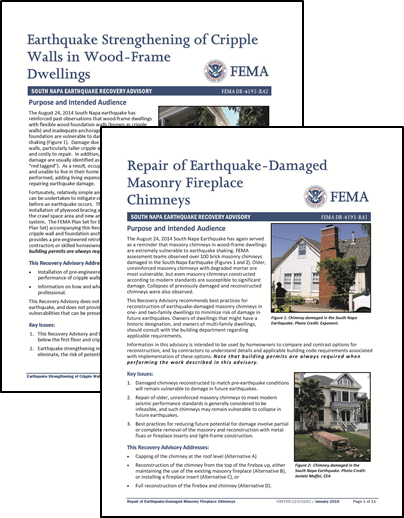
This FEMA Recovery Advisory recommends best practices for the reconstruction of earthquake-damaged masonry chimneys in one- or two-family dwellings to minimize risk of damage in future earthquakes. The best practices detailed in this advisory are also recommended for retrofit of masonry chimneys. The information included in the Recovery Advisory is intended to be used by homeowners to compare and contrast the various options for reconstruction and retrofit, as well as by contractors to understand details and applicable building code requirements associated with the implementation of these options. Readers should note that this Recovery Advisory does not fully detail construction requirements; a homeowner or contractor will still need to obtain a building permit to perform the work described in this advisory.
Earthquake Strengthening of Cripple Walls in Wood-Frame Dwellings
The South Napa earthquake damaged many cripple walls in residential structures, and many of the damaged cripple walls were taller than four feet. This FEMA Recovery Advisory addresses the earthquake strengthening of cripple walls and foundation anchorage in one- or two- family residential structures, supported by elevated concrete foundation systems and cripple walls not taller than approximately seven feet. In its first part, the Recovery Advisory describes the issue of earthquake strengthening of cripple walls and foundation anchorage for a typical homeowner. The second part is an accompanying Plan Set, which provides a pre-engineered retrofit solution and step-by-step instructions for use by knowledgeable contractors or skilled homeowners in customizing the work for the conditions in a specific dwelling. The contractor or homeowner must still obtain a building permit to perform the work described in this advisory.
ATC-20-1 Bhutan Field Manual
PROJECT OVERVIEW
Title: Development of Field Manual: Postearthquake Safety Evaluation of Buildings, Bhutan Edition (ATC-20-1 Bhutan)
Funding Provided By: World Bank’s Global Facility for Disaster Reduction and Recovery (GFDRR) and the Applied Technology Council Endowment Fund
Developed By: the Applied Technology Council (ATC), GeoHazards International (GHI), and the Royal Government of Bhutan’s Department of Engineering Services (DES) and Department of Disaster Management (DDM)
Status: This document was completed in January 2015
Participants: To see a list of project participants, click here.
Final Product:
This document represents adaptations to the U.S. version of the ATC-20-1 Field Manual to account for Bhutan’s vernacular buildings, as well as Bhutan’s cultural and governmental context. During the development, a number of improvements were made to the presentation of material in the ATC-20-1 Field Manual, including a graphical format with numerous images to help engineers evaluate damaged buildings more accurately. Also, the procedures incorporate recent lessons learned during postearthquake safety evaluations following the Chile (2010) and New Zealand (2010-2011) earthquakes.
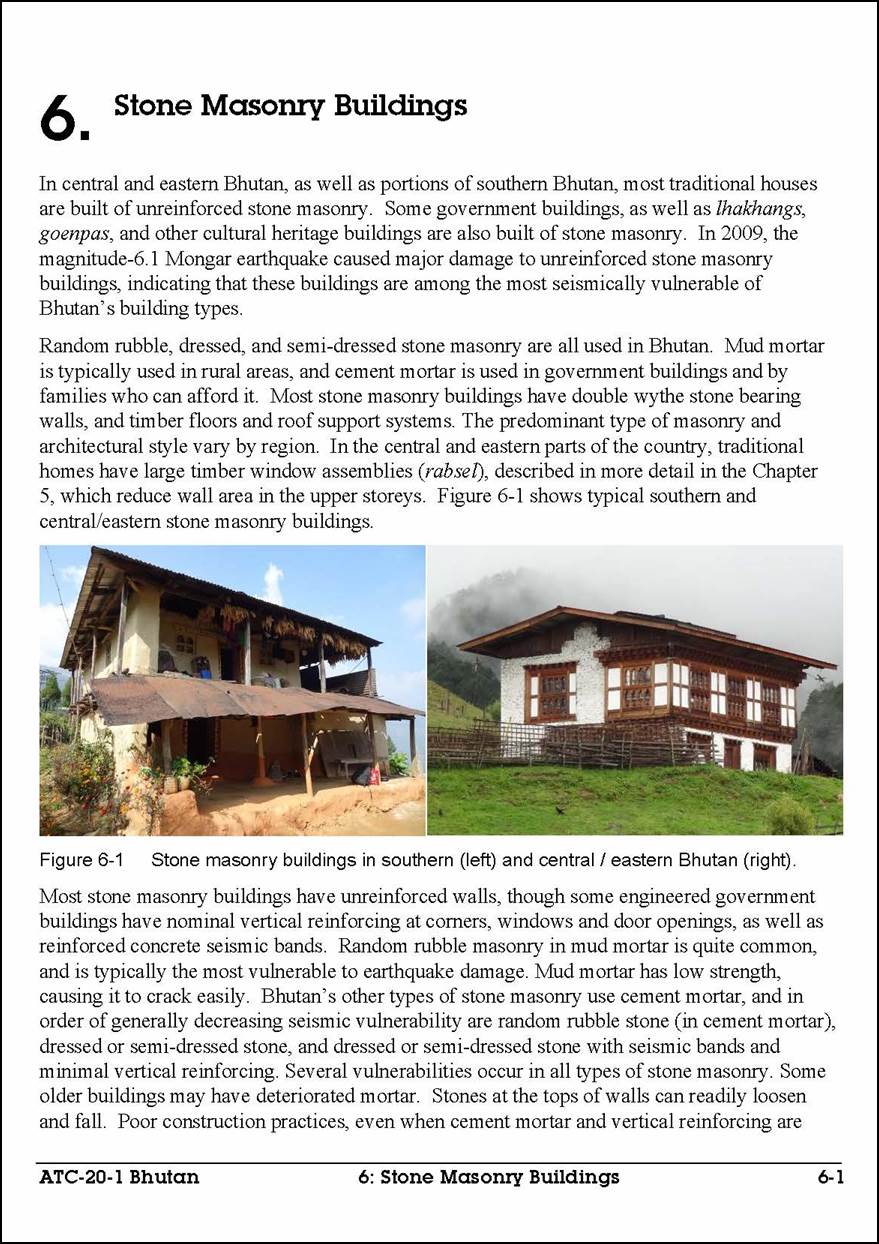 |
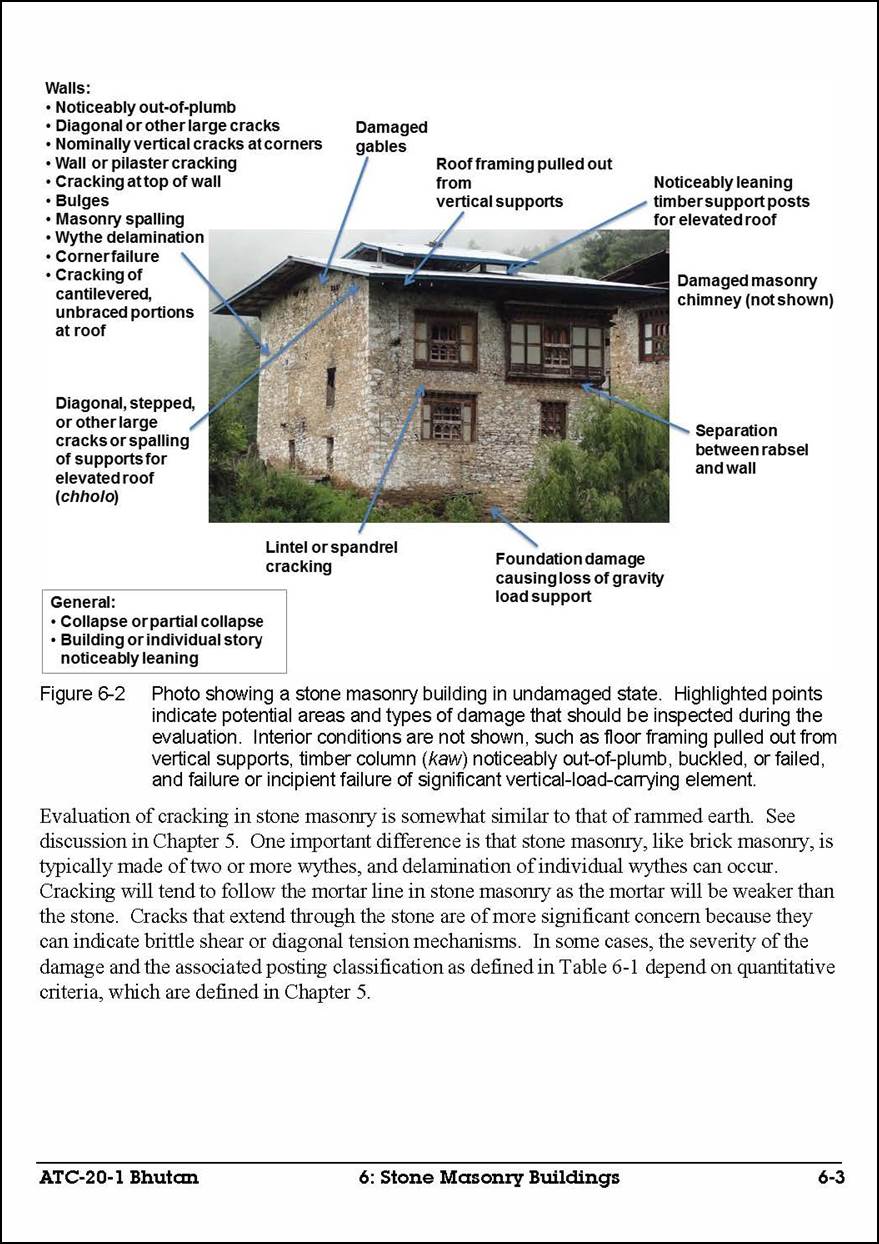 |
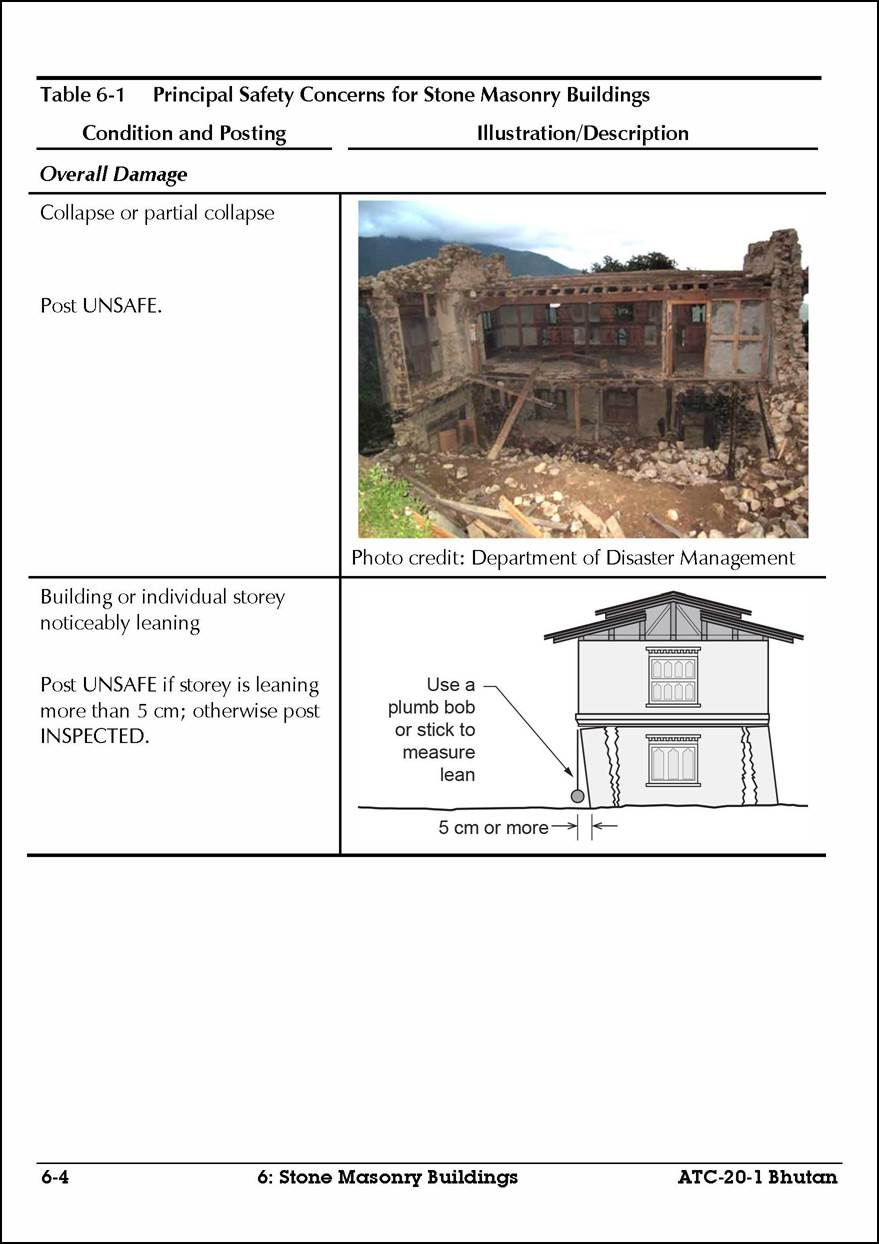 |
Sample pages from Chapter 6, Stone Masonry Buildings, showing the graphical format of the document. Table 6.1 is 13 pages long and presents damage conditions with photographs or illustrations.
An electronic copy of the document is not available online. To view the cover, title page, and table of contents, click here. If you wish to purchase a hard-copy version of the document, please contact This email address is being protected from spambots. You need JavaScript enabled to view it..
An overview of the project that developed the Field Manual was presented at the 10th National Conference on Earthquake Engineering in Anchorage, Alaska in July 2015, and may be viewed here.
In accordance with the ATC-20 Methodology, forms for recording safety evaluation results for Rapid and Detailed Evaluations were developed for buildings in Bhutan. These forms are provided in A4 size in PDF format here.
After undergoing safety evaluation, buildings are posted with one of three placards: INSPECTED, RESTRICTED USE, or UNSAFE. These forms are provided in A4 size in PDF format here.
ATC-20-1 Bhutan Field Manual also presents interim procedures for advisory placarding of single-family homes. When this document was developed, Bhutan had limited resources for response and recovery. The Department of Disaster Management determined that the results of postearthquake safety evaluations should be provided as safety advisories for occupants of single-family homes. The Department is working to enhance response capacity and intends that the provisions in this appendix serve as an interim measure. The technical developers of this document, including the U.S.-Bhutan Project Engineering Panel, ATC, GeoHazards International, and Department of Engineering Services, believe that mandatory placarding, in which directives on placards are legally binding and enforceable, is essential for public safety. The technical developers strongly support efforts to move to mandatory placarding for all buildings as soon as possible. The procedures are presented in Appendix F of the document. The advisory placards for INSPECTED, RESTRICTED USE, and UNSAFE are provided in A4 size in PDF format here.
PROJECT OVERVIEW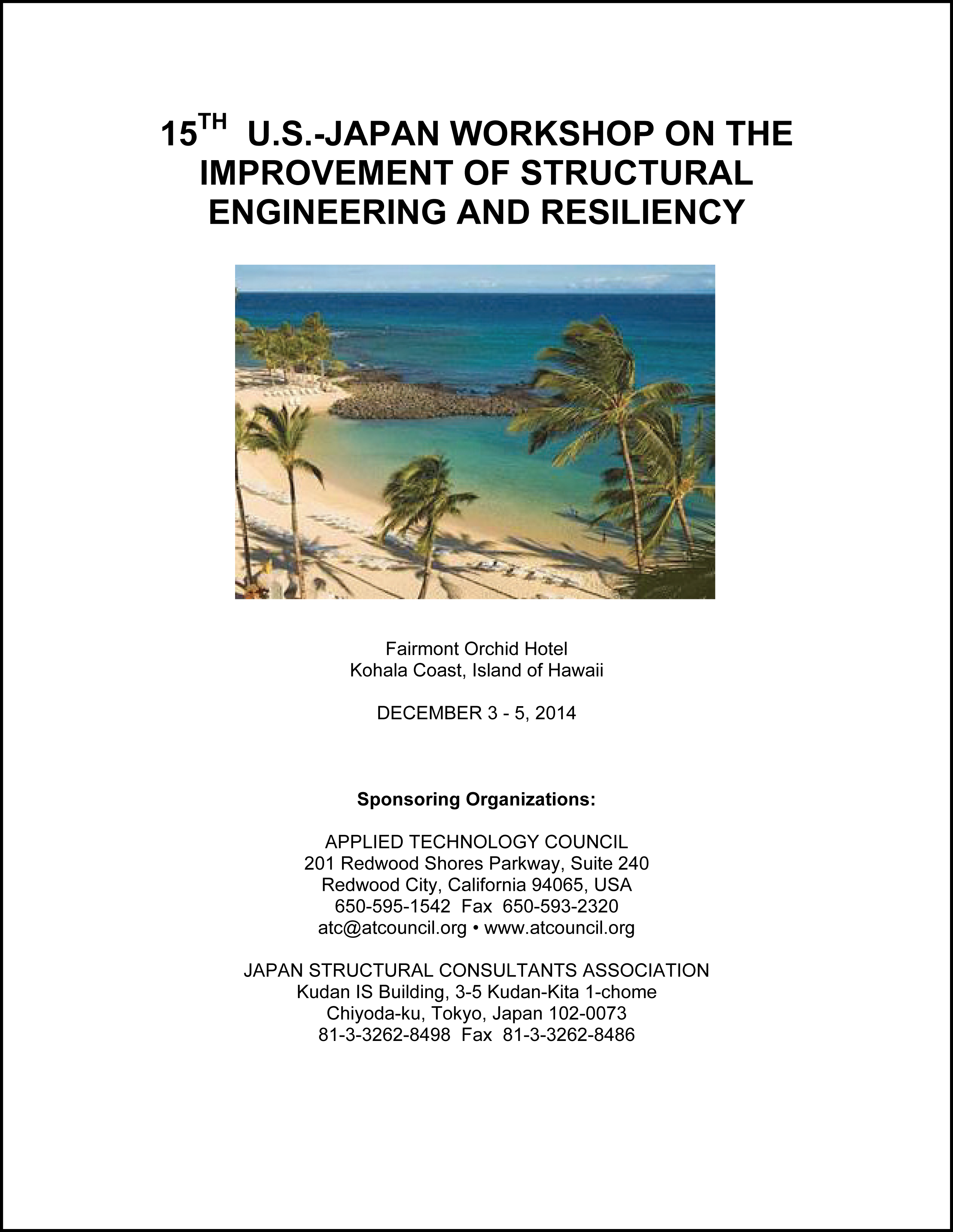
Title: 15th U.S.-Japan Workshop on the Improvement of Structural Engineering and Resiliency
Project Status: This Workshop was conducted on December 3-5, 2014
Sponsors: Applied Technology Council (ATC) and Japan Structural Consultants Association (JSCA)
PROJECT SUMMARY
The Purpose of the Workshop was to develop policy recommendations for improved community resilience based on the current state-of-practice, innovative engineering solutions, and new and emerging technologies. A special focus of the Workshop was on the means to build resiliency, reduce economic losses, and speed recovery and reconstruction following typhoons or hurricanes, earthquakes, and other natural disasters.
The Workshop is the 15th in a series started in 1984, and repeated every two-to-three years. Previous workshops have been held in California (San Diego and San Francisco), Hawaii (Honolulu, Kauai, Kona, Kohala Coast, and Maui), Japan (Kobe and Tokyo), and Victoria, British Columbia.
Workshop Participants. The Workshop Participants included those with a background in building performance and other structures in severe earthquakes, including the effects of tsunami, and response and recovery.
Workshop Program. The Workshop Program was designed for practicing structural engineers and researchers, and included technical presentations, and working group breakout sessions and discussions. Papers and presentations were as follows:
|
Session I: Resiliency-Based Design: Progress and Developments |
|||
|
Paper Number |
Paper Title | Author | Presentation |
|
1. |
Thoughts and Ideas on the Improvement of Structural Engineering and Resilience for Natural Hazards | Alexander Yanev and Peter Yanev* |
View Presentation |
|
2. |
Development of Resilient Reinforced Concrete Building Structure | Seitaro Tajiri*, Hiroshi Fukuyama, and Tomohisa Mukai | View Presentation |
|
3. |
Resilience of Steel Moment-Frame Buildings with Reserve Lateral Strength | Johnn P. Judd* and Finley A. Charney |
View Presentation |
|
4. |
Structural Design of the Seismic Response Controlled Buildings with Robustness | Shinya Nishimoto*, Yozo Shinozaki, Megumi Kawasaki, and Koji Tsuchimoto |
View Presentation |
|
5. |
Utilizing Damping Devices to Improve Resiliency of Structures | Alan Klembczyk* | View Presentation |
|
6. |
Progress on Resilience-Based Seismic Design Supported by Advanced Prediction of Building Damage, Repair Cost, and Building Closure Time | Curt B. Haselton* and Jack W. Baker |
View Presentation |
|
Session II: Performance Based-Design and Response Evaluation of Structures |
|||
|
Paper Number |
Paper Title | Author | Presentation |
|
1. |
A New Framework for Quantifying Ground Motion Intensity to Estimate Collapse Vulnerability of Buildings | Kenny Buyco*, Thomas Heaton, Anna Olsen, John Hall, and Shiyan Song |
View Presentation |
|
2. |
Seismic Response Control of the Building Having Large Space with Dampers | T. Haijima* | View Presentation |
|
3. |
Performance Target Choices by Owners Under ASCE 7-10 and ASCE 41-13: Improving Seismic Resiliency and Reducing Seismic Risk in the Legal Arena |
Mark N. White*, Cynthia L. Perry, Eduardo Fierro, Toyu Yazaki, and Junko Yazaki |
View Presentation |
|
4. |
Resilient Seismic Upgrade of Bay Division Pipeline No. 3 at the Hayward Fault | Changmo Kwon | View Presentation |
|
5. |
Response Reduction Effect of Soil-Structure-Interaction Evaluated by System Identification of Strong Motion Records Observed in 2011 East Japan Earthquake |
Hajime Okano* and Tatsuya Azuhata |
View Presentation |
|
6. |
Seismic Design of Japanese Nuclear Power Plants and Their Actual Response in the July 2007 Chuetsu-oki Earthquake | Akira Wada* and Katsuichiro Hijikata |
View Presentation |
|
Session III: Risk Identification and Reduction: Methods and Validation |
|||
|
Paper Number |
Paper Title |
Author | Presentation |
|
1. |
A Risk Communication Game-Changer: The U.S. Resiliency Council (USRC) Building Rating System |
Jon A. Heintz* | View Presentation |
|
2. |
The ATC-78 Methodology for Evaluation and Mitigation of Nonductile Concrete Buildings | Abbie Liel* | View Presentation |
|
3. |
Performance of Buildings and Nonstructural Components in the South Napa Earthquake | John Gillengerten* | View Presentation |
|
4. |
Modified Displacement-Based Design for Reinforced Masonry Shear Wall Structures | Farhad Ahmadi* | View Presentation |
|
5. |
Presentation on Similar Efforts in Japan | Mitsuru Kawamura* | View Presentation |
Session IV: Multi-Hazard Design, Analysis and Research: Buildings & Critical Infrastructure |
|||
|
Paper Number |
Paper Title |
Author | Presentation |
|
1. |
Multi-Hazard and Resilience Research at Rensselaer |
Franklin T. Lombardo* | View Presentation |
|
2. |
Resiliency of Power Systems in the United States for Earthquakes and Windstorms and Firestorms | John Eidinger* | View Presentation |
|
3. |
Performance of Base Isolated Structure for Tsunami Loading | Mineo Takayama* | View Presentation |
|
4. |
Reliability Analysis of Structures Designed in Accordance with ASCE 7, when Subjected to Tsunami and Earthquake Effects | Gary Chock* and Nico Luco | View Presentation |
|
Session V: Systems and Processes to Improve Emergency Response, Reconstruction, and Recovery |
|||
|
Paper Number |
Paper Title |
Author | Presentation |
|
1. |
Examples of Recovery Proposals and Recovery Process |
Mitsuru Kawamura* | View Presentation |
|
2. |
Measuring lifeline emergency response using temporal network models | Gian Paolo Cimellaro* | View Presentation |
|
3. |
Development of an Open Source Structural Health Monitoring and Damage Detection System for Sustainable and Resilient Structures | Erol Kalkan*, Jon P. Fletcher, Lawrence Baker, Paul Friberg, and William Leith | View Presentation |
|
4. |
Improving Community Resilience Through Public-Private Partnership: The BORP Strategy | Matthew Bogaard* | View Presentation |
|
5. |
What is needed for resiliency of tall buildings in San Francisco and elsewhere? | Mehmet Çelebi* | View Presentation |
|
Session VI: Humanitarian Engineering: The Role of Engineering and Technology in Less-Developed Communities |
|||
|
Paper Number |
Paper Title |
Author | Presentation |
|
1. |
Improving Earthquake Resiliency in Developing Cities |
Hideki Kit Miyamoto* | View Presentation |
|
2. |
‘Ductility’ is ‘Damage’, People Don’t Want to Live in Damaged Buildings | Akira Wada* | View Presentation |
|
3. |
Saving Lives through Humanitarian Engineering | Sabine Kast* | View Presentation |
|
4. |
An Example of Improving Earthquake Safety Project in South-east Asia | Takayuki Teramoto* | View Presentation |
|
5. |
Effectively Adapting and Adopting Risk Reduction Technologies in Emerging Communities | Verónica Cedillos* | View Presentation |
|
Session VII: Closing Session |
|||
|
Paper Number |
Paper Title | Author | Presentation |
|
1. |
Special Presentation: Personal Message to Participants from Roland Sharpe—U.S. Founder of the U.S.-Japan Workshop series | Roland Sharpe (presented by Christopher Rojahn) | View Presentation |
|
2. |
Summary and Conclusions | Mitsuru Kawamura*, Christopher Rojahn*, Kit Miyamoto* | View Presentation |
*Presenting Author.

